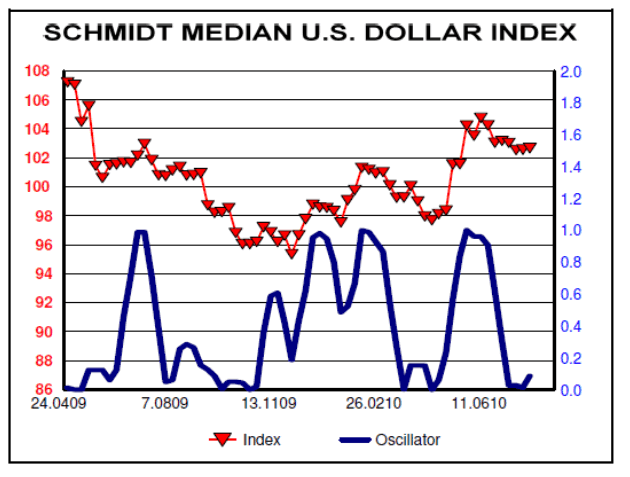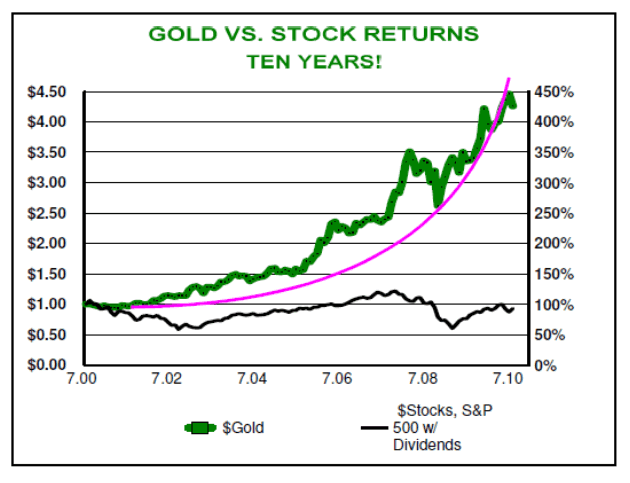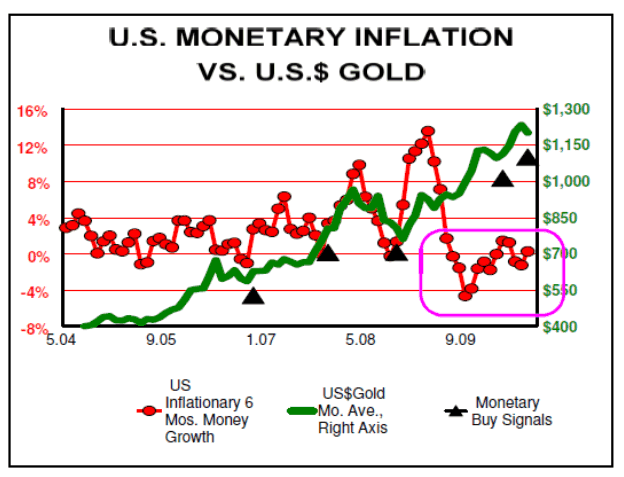Gold Diverging Trend From Weak U.S. Monetary Inflation
Commodities / Gold and Silver 2010 Jul 23, 2010 - 11:52 AM GMTBy: Ned_W_Schmidt
 We seem to do a lot of waiting. As 2009 ended, U.S. dollar was being forecast to be approaching the end of its existence. Presumably, we must continue to wait for that event. Moving on, forecasters had more recently been calling for imminent collapse of EU and vaporization of the Euro. Presumably, we must continue to wait for that event too. Many are still forecasting an imminent replacement of global currencies with Gold. Presumably, we must continue to wait for that too.
We seem to do a lot of waiting. As 2009 ended, U.S. dollar was being forecast to be approaching the end of its existence. Presumably, we must continue to wait for that event. Moving on, forecasters had more recently been calling for imminent collapse of EU and vaporization of the Euro. Presumably, we must continue to wait for that event too. Many are still forecasting an imminent replacement of global currencies with Gold. Presumably, we must continue to wait for that too.

Our first chart this week, below, is of an index for the value of the U.S. dollar versus 12 currencies. This measure avoids the structural problems of the popular trade-weighted index. Quite frankly, due to its construction, using the trade-weighted index for the dollar to forecast anything is a fruitless effort. Values for currencies in the modern era are determined by capital flows, not by arbitrary weightings of trade from yesteryear.
Anyway, what can we say about that picture? Does it look like a value about ready to collapse? Rather, it is at present over sold, and may be preparing for another rally. Rather than collapse, the dollar appears to be involved in a rather substantial advance. Should that continue, one wonders how $Gold will be able to move higher. And from that, flows another question. Why has $Gold been so strong in an environment where the dollar has also been strong?
Today, emotions rather than fundamentals are driving $Gold. That makes for a high risk situation, one from which disappointment might be spawned. Sentiment changed for the positive on Gold in late 2009. Funds and traders, that had previously ignored Gold and missed most of a decade long run, suddenly rushed into the market. After nearly ten years of exceptional performance, these light weight thinkers have discovered Gold. It is now an investment fad, and fads are transitory events.
Rather than presenting a picture that suggests an imminent lift off of $Gold to levels such as $5000 or $10,000, prices which are conceivable only in a state of delusion, $Gold may in the short-term be vulnerable to a shift in sentiment. Returns as shown in the following graph have been attracting those that did not see that Gold as undervalued relative to paper assets in prior years. When coming across outrageous forecasts for $Gold or managers that have in the past year plunged their clients into Gold, ask one question. Which asset, paper stocks or Gold, were they recommending in 1999?

In the above graph we have highlighted the parabolic rise evident in $Gold. That a parabolic rise has developed in not arguable. What is arguable is where to place the curve and when it will be resolved. And we note, all parabolic rises are resolved. They never go on forever, or we would still be talking about internet stocks. A one third correction out of that parabolic curve would be the start of a working forecast. (And please, do not send emails about that drivel of inflating an old Gold price with some faulty measure of inflation. Such calculations are nonsense.)
Unlike those corrections out of paper asset parabolic rises, Gold is not going to disappear. It has regained a permanent place in investment portfolios. Fears of central bank liquidation of Gold reserves, for example, have been replaced by evidence of accumulation. bloomberg.com(22 July) reports that central banks and governments added more than 400 tons to Gold reserves last year, and that is the first increase since 1988. With a generation learning the wisdom of asset diversification to include Gold, that education will not fade quickly. Any resolution of the $Gold parabolic should be considered a valley between mountains.
Also, we do share the view that ultimately the fiscal irresponsibility of the Obama Regime must be faced. The Obama Debt Debacle can be resolved in two ways. One is a lower standard of living. Such is the method being applied in the PIGS, and is likely to also be the experience in the U.S. A second is through an inflationary expansion of the money supply. That approach remains a possibility, though at the present only a remote one. With U.S. interest rates already at a low level, how is that to be done? Japan could not do it. Does Bernanke have some secret monetary tool, or is he just too deluded by Keynesian dogma?

Our last chart below is part of the uncertainty that exists on the future path of $Gold. Fundamental and technical indicators are not now in unison. This chart is one which we have considered before. Green line is the monthly average price of $Gold, using right axis. Line of red circles is the inflationary component of U.S. money supply growth, M-2 NSA, using the left axis.
Recent experience of the inflationary component of U.S. money supply growth has been highlighted in the chart. Reflecting this non inflationary monetary growth rate, U.S. inflation has been essentially non existent. That said, this measure is again trying to turn positive. When the growth rate of the inflationary component of U.S. money supply growth goes from negative to positive, $Gold tends to act better in the future. Triangles represent the buy signals created by this rule. We note another signal is attempting to form, though data for July is certainly limited at this time.
In short, Gold investors must be attuned to possibility of a corrective process developing out of the developing parabolic formation. We know neither the timing of that corrective process nor the size of such a move. Counterbalance to that expectation is that U.S. money supply growth might be accelerating, as indicated in our last chart. Longer term, the Obama Debt Debacle will have ramifications for the dollar and the value of $Gold. From that we conclude: Hold that Gold.
By Ned W Schmidt CFA, CEBS
GOLD THOUGHTS come from Ned W. Schmidt,CFA,CEBS, publisher of The Value View Gold Report , monthly, and Trading Thoughts , weekly. To receive copies of recent reports, go to www.valueviewgoldreport.com
Copyright © 2010 Ned W. Schmidt - All Rights Reserved
Ned W Schmidt Archive |
© 2005-2022 http://www.MarketOracle.co.uk - The Market Oracle is a FREE Daily Financial Markets Analysis & Forecasting online publication.



